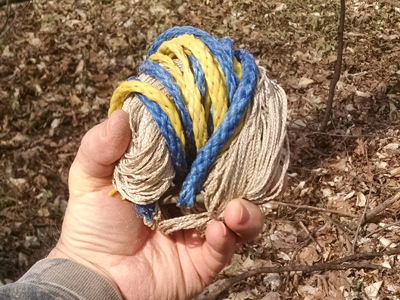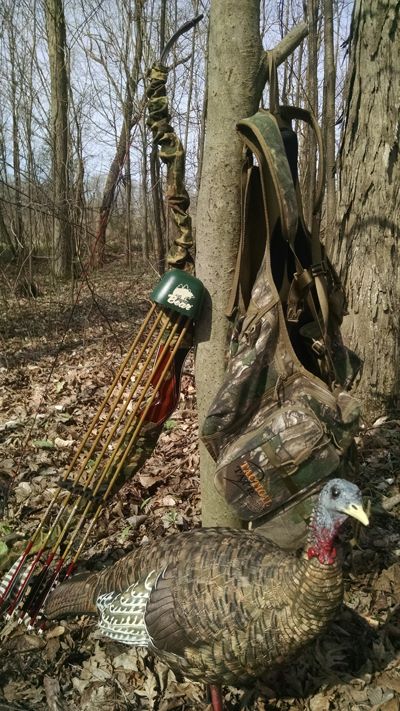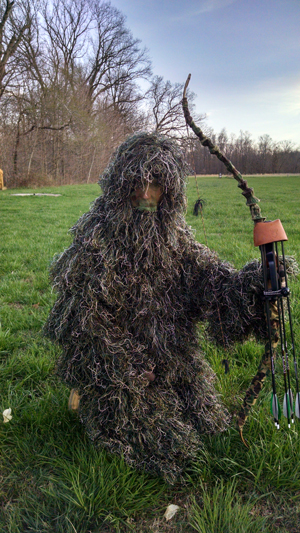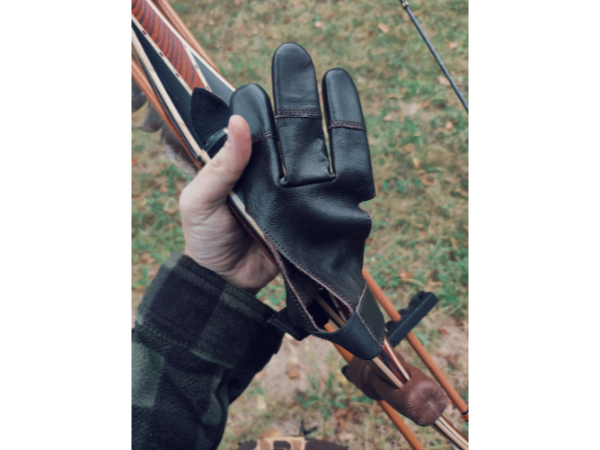I have always been a stay-all-day hunter when it comes to turkeys. Due to my ability to comfortably stay in the woods after the peak gobbling time in the morning is over, I have on several occasions carried a gobbler out of the woods during the middle of the day.
The odds are against a traditional bowhunter when it comes to turkeys, so staying all day increases your odds substantially. Having a lot of time on my hands, due to the stay at home order because of the Covid-19 pandemic, and turkey season fast approaching here in Indiana, I thought I would share my top six items that I need to get through a full day of turkey hunting.
 My most important piece of equipment for staying all day is my portable hammock. It rolls up to the size of a softball and stays tucked away in my turkey vest until after the gobblers have gone silent for the morning and have taken up company with their hens. That’s when my hammock comes out and I hang out in comfort while I wait for the hens to leave the gobblers and head for the nest. This is a good time to crank back and catch a nap, especially after several days of rising early to chase after America’s greatest game bird.
My most important piece of equipment for staying all day is my portable hammock. It rolls up to the size of a softball and stays tucked away in my turkey vest until after the gobblers have gone silent for the morning and have taken up company with their hens. That’s when my hammock comes out and I hang out in comfort while I wait for the hens to leave the gobblers and head for the nest. This is a good time to crank back and catch a nap, especially after several days of rising early to chase after America’s greatest game bird.
It usually doesn’t take long for the gobblers to get lonely after the hens leave them, and they start up gobbling again. A lonely gobbling bird, in the middle of the day when the hens are on the nest, is usually an easy bird to convince that you are just the lady that he is looking for. You will be surprised how much action takes place during the middle of the day in the turkey woods. I have learned a lot over the last 38 years just lying in my hammock listening to turkeys sound off at different times of the day.
The second important thing is food and water. I like to take food that doesn’t have to be kept cold. Most of the time I carry a couple cans of sardines in mustard sauce with a pull top lid. You can substitute tuna if you don’t like sardines. This is a good high energy protein meal that won’t spoil. Mustard sauce only for me though. I usually throw in some cheese sticks, corn chips and some oatmeal granola bars. I try to eat the cheese sticks up before they get too warm in my vest. You can figure out what works best for you. Three bottles of water usually gets me through the day.
 The third important thing is toilet paper. Nothing will make you leave the woods faster than not having toilet paper. If it doesn’t, then you are just tougher than me. I have been around several hunters, galled by the end of the day, who didn’t come prepared to act like a bear in the woods.
The third important thing is toilet paper. Nothing will make you leave the woods faster than not having toilet paper. If it doesn’t, then you are just tougher than me. I have been around several hunters, galled by the end of the day, who didn’t come prepared to act like a bear in the woods.
My favorite turkey calls are number four on my list. I like to have a couple of mouth diaphragm calls, which I make myself. This allows my hands to be free when the gobbler gets close. Learning how to use a mouth call will pay off here. I also carry a homemade slate that sits in a Skoal can. I won’t leave home without one in my turkey vest. I have killed a lot of gobblers over the last 38 years using that call. To top that off, I have an aluminum pot call to pierce the air for those long-distance gobblers, or when I’m tired of using my mouth calls. The aluminum call works well on windy days when sound doesn’t carry real far. Once the turkey starts coming toward me, I will switch over to my Skoal can slate and mouth call.
Number five on my list is a hen decoy. Hunting turkeys with a traditional bow is hard enough, having something for the gobbler to focus his attention on while you draw your bow is a big advantage. I like to sit out in the open with my ghillie suit on, so I wait until the gobbler is strutting for the decoy and facing away so his tail fan is blocking his view of me drawing my bow. Aiming at the base of his tail fan will send the arrow into his vitals. If he is sideways, then aim for the wing butt. Be careful if you can see his eyes. Practice drawing your bow very slowly. I have been able to reach full draw on several gobblers that were 10 yards or less away by drawing in slow motion while the gobbler was totally focused on the decoy.
The vitals on a turkey are about the size of a softball, so I will set my decoy no more than 15 yards away. I prefer 10 yards or less if the terrain allows. I like to have some kind of vegetation behind me. I have found that as long as I hold still in my ghillie suit the turkeys won’t pay any attention to me. I have got off more than one shot after missing a gobbler that was less than 10 yards away. Keep a second arrow handy for this reason. Also, spend the extra money on a good realistic decoy. It will make a big difference in fooling that strutting tom.
And finally, a good set of binoculars is a must for me. I feel like I’m at a big disadvantage without them. When I’m not lying in my hammock, I will travel from field to field glassing for turkeys. If I do see a gobbler I will try to sneak as close as I can without exposing myself to his keen eyesight. I will then pop my decoy out between us and try to call him over a rise to see the hen that’s making those lovesick calls. I like to set up where a gobbler has to come over a rise in the terrain and be close to my calling position before he can see my decoy and strut his stuff. This keeps him from hanging up out of range and expecting the fake hen to come to him. The closer you can get to a gobbler before you start to call makes it less likely something will go wrong before he gets to you, like a predator or a real hen.
 A short bow works best when sitting on the ground, like I do. A shorter bow will give you plenty of clearance between the ground and your bottom limb tip. I like a 58” bow, or less, and I learned this the hard way. My favorite setup is my Bear “A” handle takedown with number one limbs in 45 pound draw weight. This makes for a 56” bow that draws smooth when you’re drawing down on that sharp-eyed gobbler.
A short bow works best when sitting on the ground, like I do. A shorter bow will give you plenty of clearance between the ground and your bottom limb tip. I like a 58” bow, or less, and I learned this the hard way. My favorite setup is my Bear “A” handle takedown with number one limbs in 45 pound draw weight. This makes for a 56” bow that draws smooth when you’re drawing down on that sharp-eyed gobbler.
In closing I would say my portable hammock is my secret weapon in my turkey hunting arsenal. Add food, water and toilet paper to make for a pretty comfortable day in the springtime woods. My hammock keeps me up out of the ticks and bugs, too, while I wait out that old gobbler.
The moral of the story is, if you are comfortable and not hungry you will spend a whole lot more time in the field chasing turkeys, instead of back at the truck or home. This will increase the odds of carrying out a turkey over your shoulder. And if you come out empty-handed you will be well-rested and your buddies will think you are tougher than they are.







Leave A Comment